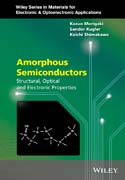
Amorphous Semiconductors: Structural, Optical, and Electronic Properties
Morigaki, Kazuo
Kugler, Sandor
Shimakawa, Koichi
Amorphous semiconductors are subtances in the amorphous solid state that have the properties of a semiconductor and which are either covalent or tetrahedrally bonded amorphous semiconductors or chelcogenide glasses. Developed from both a theoretical and experimental viewpoint Deals with, amongst others, preparation techniques, structural, optical and electronic properties, and light induced phenomena Explores different types of amorphous semiconductors including amorphous silicon, amorphous semiconducting oxides and chalcogenide glasses Applications include solar cells, thin film transistors, sensors, optical memory devices and flat screen devices including televisions INDICE: Series Preface xi .Preface xiii .1 Introduction 1 .1.1 General Aspects of Amorphous Semiconductors 1 .1.2 Chalcogenide Glasses 3 .1.3 Applications of Amorphous Semiconductors 3 .References 3 .2 Preparation Techniques 5 .2.1 Growth of a Si:H Films 5 .2.1.1 PECVD Technique 5 .2.1.2 HWCVD Technique 6 .2.2 Growth of Amorphous Chalcogenides 6 .References 8 .3 Structural Properties of Amorphous Silicon and Amorphous Chalcogenides 11 .3.1 General Aspects 11 .3.1.1 Definitions of Crystalline and Noncrystalline 11 .3.2 Optical Spectroscopy 12 .3.2.1 Raman Scattering 12 .3.2.2 Infrared Absorption 13 .3.3 Neutron Diffraction 15 .3.3.1 Diffraction Measurements on Amorphous Silicon 17 .3.3.2 Diffraction Measurements on Hydrogenated Amorphous Silicon 18 .3.3.3 Diffraction Measurements on Amorphous Germanium 19 .3.3.4 Diffraction Measurements on Amorphous Selenium 19 .3.4 Computer Simulations 20 .3.4.1 Monte Carlo Type Methods for Structure Derivation 20 .3.4.2 Atomic Interactions 21 .3.4.3 a Si Models Constructed by Monte Carlo Simulation 25 .3.4.4 Reverse Monte Carlo Methods 26 .3.4.5 a Si Model Constructed by RMC Simulation 28 .3.4.6 a Se Model Constructed by RMC Simulation 30 .3.4.7 Molecular Dynamics Simulation 32 .3.4.8 a Si Model Construction by Molecular Dynamics Simulation 34 .3.4.9 a Si:H Model Construction by Molecular Dynamics Simulation 34 .3.4.10 a Se Model Construction by Molecular Dynamics Simulation 35 .3.4.11 Car and Parrinello Method 38 .References 38 .4 Electronic Structure of Amorphous Semiconductors 43 .4.1 Bonding Structures 43 .4.1.1 Bonding Structures in Column IV Elements 44 .4.1.2 Bonding Structures in Column VI Elements 45 .4.2 Electronic Structure of Amorphous Semiconductors 46 .4.3 Fermi Energy of Amorphous Semiconductors 47 .4.4 Differences between Amorphous and Crystalline Semiconductors 49 .4.5 Charge Distribution in Pure Amorphous Semiconductors 49 .4.6 Density of States in Pure Amorphous Semiconductors 52 .4.7 Dangling Bonds 54 .4.8 Doping 57 .References 58 .5 Electronic and Optical Properties of Amorphous Silicon 61 .5.1 Introduction 61 .5.2 Band Tails and Structural Defects 62 .5.2.1 Introduction 62 .5.2.2 Band Tails 62 .5.2.3 Structural Defects 66 .5.3 Recombination Processes 68 .5.3.1 Introduction 68 .5.3.2 Radiative Recombination 68 .5.3.3 Nonradiative Recombination 70 .5.3.4 Recombination Processes and Recombination Centers in a Si:H 72 .5.3.5 Spin Dependent Recombination 73 .5.4 Electrical Properties 74 .5.4.1 DC Conduction 74 .5.4.2 AC Conduction 80 .5.4.3 Hall Effect 87 .5.4.4 Thermoelectric Power 88 .5.4.5 Doping Effect 89 .5.5 Optical Properties 92 .5.5.1 Fundamental Optical Absorption 92 .5.5.2 Weak Absorption 94 .5.5.3 Photoluminescence 96 .5.5.4 Frequency Resolved Spectroscopy (FRS) 96 .5.5.5 Photoconductivity 101 .5.5.6 Dispersive Photoconduction 109 .5.6 Electron Magnetic Resonance and Spin Dependent Properties 112 .5.6.1 Introduction 112 .5.6.2 Electron Magnetic Resonance 112 .5.6.3 Spin Dependent Properties 128 .5.7 Light Induced Phenomena and Light Induced Defect Creation 131 .5.7.1 Introduction 131 .5.7.2 Light Induced Phenomena 132 .5.7.3 Light Induced Defect Creation 134 .References 145 .6 Electronic and Optical Properties of Amorphous Chalcogenides 157 .6.1 Historical Overview of Chalcogenide Glasses 157 .6.1.1 Applications 157 .6.1.2 Science 158 .6.2 Basic Glass Science 159 .6.2.1 Glass Formation 159 .6.2.2 Glass Transition Temperature 160 .6.2.3 Crystallization of Glasses 162 .6.3 Electrical Properties 165 .6.3.1 Electronic Transport 165 .6.3.2 Ionic Transport 170 .6.4 Optical Properties 175 .6.4.1 Fundamental Optical Absorption 175 .6.4.2 Urbach and Weak Absorption Tails 178 .6.4.3 Photoluminescence 179 .6.4.4 Photoconduction 183 .6.5 The Nature of Defects, and Defect Spectroscopy 191 .6.5.1 Electron Spin Resonance 196 .6.5.2 Optical Absorption 197 .6.5.3 Primary Photoconductivity 197 .6.5.4 Secondary Photoconductivity 197 .6.5.5 Electrophotography 199 .6.5.6 Electronic Transport 199 .6.6 Light Induced Effects in Chalcogenides 200 .6.6.1 Electron Spin Resonance 200 .6.6.2 Optical Absorption 202 .6.6.3 Photoluminescence 203 .6.6.4 Photoconductivity 205 .6.6.5 Electronic Transport 206 .6.6.6 Defect Creation Kinetics 207 .6.6.7 Structure Related Properties 210 .References 218 .7 Other Amorphous Material Systems 231 .7.1 Amorphous Carbon and Related Materials 231 .7.1.1 Basic Structure of a C (sp2 Hybrids) 232 .7.1.2 Preparation Techniques 233 .7.1.3 Brief Review of Structural Studies on Amorphous Carbon 233 .7.1.4 Applications 234 .7.2 Amorphous Oxide Semiconductors 235 .7.2.1 Preparation Techniques 235 .7.2.2 Optical Properties 236 .7.2.3 Electronic Properties 237 .7.2.4 Applications 239 .7.3 Metal Containing Amorphous Chalcogenides 239 .7.3.1 Preparation Techniques 240 .7.3.2 Structure of Ag Chs and Related Physical Properties 240 .7.3.3 Photodoping 241 .7.3.4 Applications 242 .References 242 .8 Applications 247 .8.1 Devices Using a Si:H 247 .8.1.1 Photovoltaics 247 .8.1.2 Thin Film Transistors 248 .8.2 Devices Using a Chs 249 .8.2.1 Phase Change Materials 249 .8.2.2 Direct X ray Image Sensors for Medical Use 257 .8.2.3 High Gain Avalanche Rushing Amorphous Semiconductor Vidicon 258 .8.2.4 Optical Fibers and Waveguides 260 .References 261 .Index 265
- ISBN: 978-1-118-75792-5
- Editorial: Wiley–Blackwell
- Encuadernacion: Cartoné
- Páginas: 288
- Fecha Publicación: 03/03/2017
- Nº Volúmenes: 1
- Idioma: Inglés
